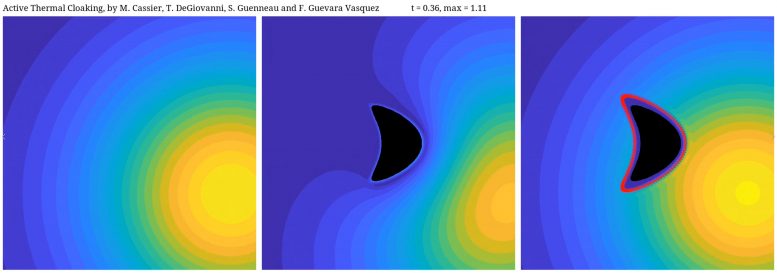How to Cloak an Object to Become Invisible to a Thermal Camera

Theoretical method can make objects invisible to a thermal camera, or mimic a different object.
Can you feel the heat? To a thermal camera, which measures infrared radiation, the heat that we can feel is visible, like the heat of a traveler in an airport with a fever or the cold of a leaky window or door in the winter.
In a paper published in Proceedings of the Royal Society A: Mathematical, Physical and Engineering Sciences, an international group of applied mathematicians and physicists, including Fernando Guevara Vasquez and Trent DeGiovanni from the University of Utah, report a theoretical way of mimicking thermal objects or making objects invisible to thermal measurements. And it doesn’t require a Romulan cloaking device or Harry Potter’s invisibility cloak. The research is funded by the National Science Foundation.
The method allows for fine-tuning of heat transfer even in situations where the temperature changes in time, the researchers say. One application could be to isolate a part that generates heat in a circuit (say, a power supply) to keep it from interfering with heat sensitive parts (say, a thermal camera). Another application could be in industrial processes that require accurate temperature control in both time and space, for example controlling the cooling of a material so that it crystallizes in a particular manner.
Watch a visualization of how the method cloaks a kite-shaped object here:
Left to right: 1. temperature of a plate subject to a point source firing at time t=0 (this could be e.g. a laser pulse). 2. temperature of the plate with a “kite” object present. As you can see the isotherms, or temperature contours, are deformed by the presence of the object and this can be used by an observer to detect and locate the kite. 3. the kite object is surrounded by our active cloak. Now the isotherms look exactly like the ones in the case where the object is not present, which hides the kite object. Credit: Fernando Guevara Vasquez/University of Utah
Or watch how it works for a Homer Simpson-shaped object here:
Left to right: 1. temperature of a plate subject to point source firing at time t=0 (this could be e.g. a laser pulse). 2. temperature of the plate with an object present. As you can see the isotherms, or temperature contours, are deformed by the presence of the object and this can be used by an observer to detect and locate the object. 3. The object is surrounded by our active cloak. Now the isotherms look exactly like the ones in the case where the object is not present, which hides the object. Credit: Fernando Guevara Vasquez
Cloaking or invisibility devices have long been elements of fictional stories, but in recent years scientists and engineers have explored how to bring science fiction into reality. One approach, using metamaterials, bends light in such a way as to render an object invisible.
Just as our eyes see objects if they emit or reflect light, a thermal camera can see an object if it emits or reflects infrared radiation. In mathematical terms, an object could become invisible to a thermal camera if heat sources placed around it could mimic heat transfer as if the object wasn’t there.
The novelty in the team’s approach is that they use heat pumps rather than specially crafted materials to hide the objects. A simple household example of a heat pump is a refrigerator: to cool groceries it pumps heat from the interior to the exterior. Using heat pumps is much more flexible than using carefully crafted materials, Guevara says. For example, the researchers can make one object or source appear as a completely different object or source. “So at least from the perspective of thermal measurements,” Guevara says, “they can make an apple appear as an orange.”
The researchers carried out the mathematical work needed to show that, with a ring of heat pumps around an object, it’s possible to thermally hide an object or mimic the heat signature of a different object.
The work remains theoretical, Guevara says, and the simulations assume a “probing” point source of heat that would reflect or bend around the object – the thermal equivalent of a flashlight in a dark room.
The temperature of that probing source must be known ahead of time, a drawback of the work. However the approach is within reach of current technology by using small heat pumps called Peltier elements that transport heat by passing an electrical current across a metal-metal junction. Peltier elements are already widely used in consumer and industrial applications.
The researchers envision their work could be used to accurately control the temperature of an object in space and time, which has applications in protecting electronic circuits. The results, the researchers say, could also be applied to accurate drug delivery, since the mathematics of heat transfer and diffusion are similar to those of the transfer and diffusion of medications. And, they add, the mathematics of how light behaves in diffuse media such as fog could lead to applications in visual cloaking as well.
Reference: “Active thermal cloaking and mimicking” by Maxence Cassier, Trent DeGiovanni, Sébastien Guenneau and Fernando Guevara Vasquez, 12 May 2021, Proceedings of the Royal Society A: Mathematical, Physical and Engineering Sciences.
DOI: 10.1098/rspa.2020.0941
In addition to Guevara and DeGiovanni, Maxence Cassier, CNRS Researcher at the Fresnel Institute in Marseille, France and Sébastien Guenneau, CNRS researcher, UMI 2004 Abraham de Moivre-CNRS, Imperial College London, London, UK co-authored the study.
